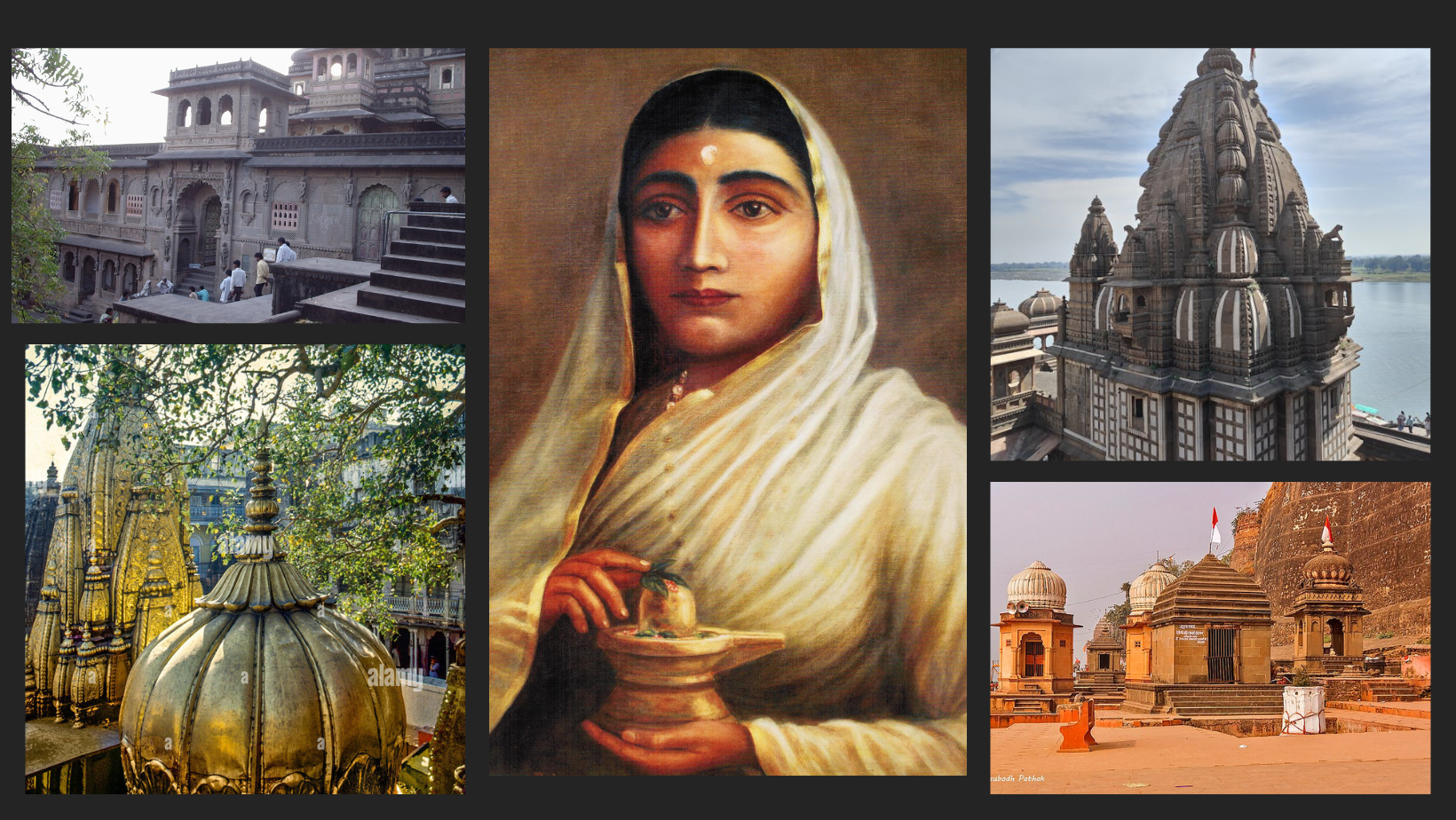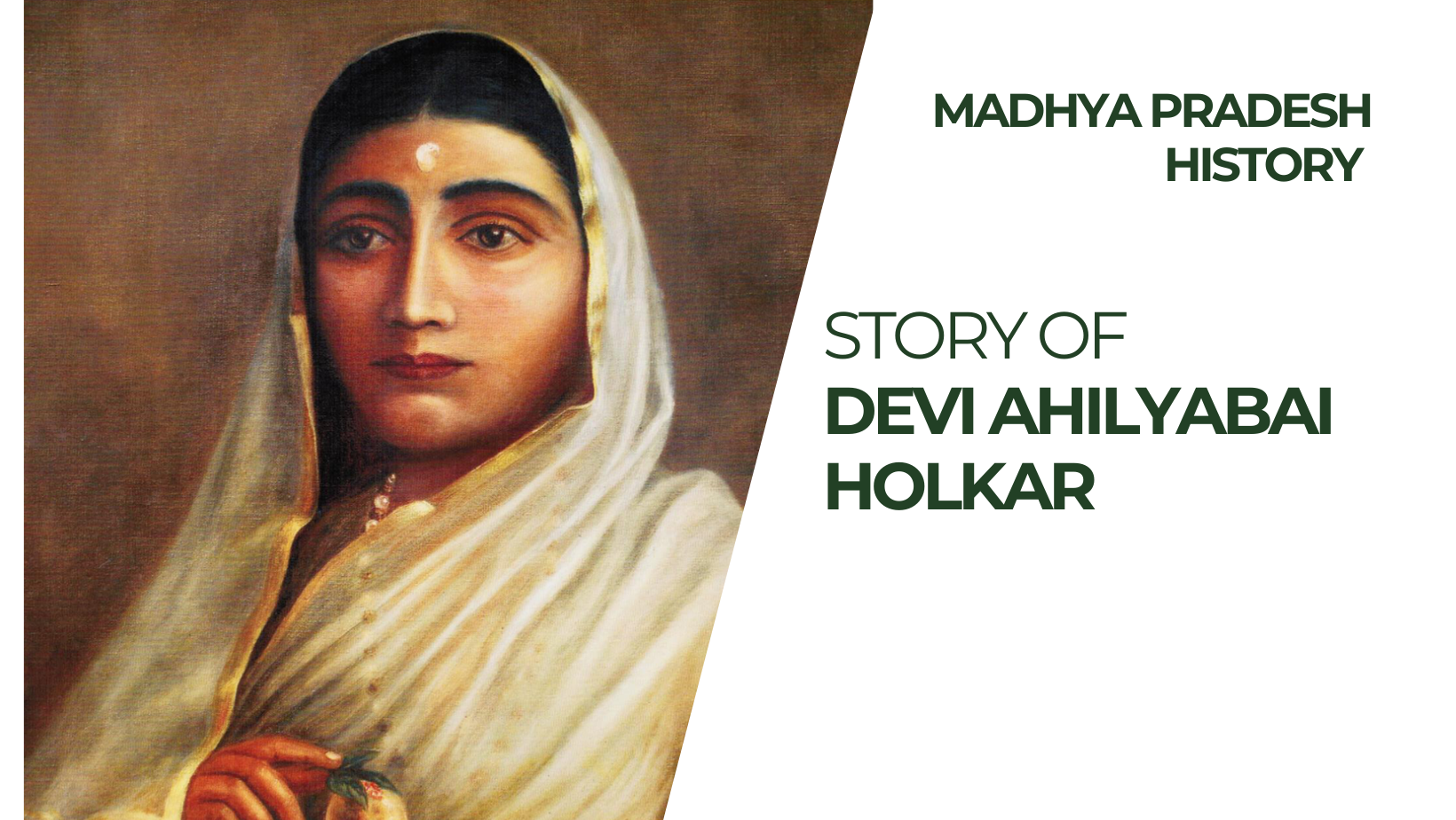About 300 years ago, Maharani Ahilyabai Holkar ruled the Malwa kingdom for 28 years, leaving a legacy of benevolent and effective governance. She is considered one of the most influential rulers in Indian history. An iron lady, she lost her husband at a young age but received training from her in-laws, enabling her to showcase a model of governance that was exceptional for her time. Ahilyabai was not only a skilled ruler but also a devout contributor to Dharma, known for her piety and dedication to her people. She constructed numerous temples, wells, and ghats, ensuring the welfare of her subjects and promoting Hindu culture and religion.1
Let’s bring her amazing story.
Early Life and Ascension to Power
Ahilya Bai was born on 31st May 1725, the daughter of village head Mankoji Shinde of Chaundi in Maharashtra. From childhood, she was closely watched by Malharrao, a senior subedar of Malwa province, who admired her keen interest in horses and elephants. This admiration led Malharrao to choose her as a bride for his son, Khanderao.
Ahilya and Khanderao were married in 1733 when Ahilya was just 8 years old. Following her marriage, Ahilya moved to Indore in the Malwa province, becoming the daughter-in-law of the esteemed Holkar family. Despite her young age, she quickly adapted to her new role and responsibilities within the royal household.
Ahilya Bai’s early years in Indore were marked by her dedication to learning and governance, setting the stage for her future reign as one of India’s most influential rulers. Her story is a testament to her strength, intelligence, and commitment to her people and culture.
The Reign of Ahilyabai Holkar: Governance and Administration


Her life’s toughest period began after 12 years of marriage in 1745 when Khanderrao was killed during the siege of Kumbher Fort. During that time, widows often performed sati, but Ahilyabai was persuaded by her father-in-law, Malharrao, to refrain. Instead, he began training her in administrative and military matters.2
After Malharrao’s death in 1766, Ahilyabai’s son, Malerao, was next in line to rule Malwa. However, the Peshwa granted her permission to take over in 1767. Ahilyabai ruled Malwa wisely and effectively for the next 28 years, showcasing remarkable leadership and governance.
Ahilyabai was also well-trained in military affairs. On one occasion, she led an expedition against the Gohadkars, capturing their fort with artillery. She even took on the task of manufacturing guns and shells, further demonstrating her military prowess and commitment to her kingdom’s defense.3
Architectural Contributions and Cultural Patronage


Rani Ahilya Bai ruled from the city of Maheshwar as the Capital of Holkar state and the majority of her public works and religious construction was done at Maheshwar. This included guest houses and ghats all over the country.
- Harsiddhi Temple: It is a very old temple of Indore situated near Harsiddhi Bridge dedicated to Goddess Durga. It was built by Devi Ahilya in the year 1793. 4
- Deo-Guradiya temple: Deo-Guradiya temple is believed to be 1000 years old temple situated at Indore-Nemawar road. The temple belongs to Gutekshwar Mahadev. As per historical records, the temple was built first by Parmar rulers of Malwa and it was again rebuilt and renovated by Devi Ahilya Bai. An idol of Lord Shiva is placed in the location of the temple that naturally springs water continuously over the Lord Shiva. It is believed whenever Devi Ahilya Bai came to Indore from Maheshwar she used to visit the temple. Later the Holkar dynasty paid their tributes to lord Shiva by attending the festival of Mahashivratri. 4
- Maheshwar Ghat: It was built by Devi Ahilyabai in the 18th century along the Narmada river. The views offered from the ghat are mesmerizing and is a famous destination. On visiting you can also take a boat ride on the river that offers a marvelous view of the Maheshwar Fort. Lately, the Ghat has become a popular attraction among Bollywood as a shooting destination as it offers a splendid view and is clean compared to other ghats. Some popular movies shot there were Tevar, Padman, Manikarnika, Yamla Pagla Deewana, and Ashoka name a few. One of the nearest destinations is Omkareshwar you can visit there too.6
- Kashi Vishwanath Temple: The temple famous for its Vishweshwara Jyotirlinga has very special significance in spirituality by having darshan of it in a single visit it is believed to earn the merits from other jyotirlinga. After the original temple was demolished by Aurangzeb, the temple was rebuilt by Devi Ahilya Bai in the year 1780 and it is still thriving in its current shape.
- Vishnupad Temple: It is another famous temple in Gaya which is dedicated to Lord Vishnu, located along the banks of Falgu River. The present structure was constructed by Devi Ahilyabai in the year 1787.7
Ahilyabai Holkar’s Social Reforms and Welfare Initiatives
Ahilyabai introduced a regiment of women to be at the forefront and under the direct command of It was after the death of Alhiybai’s son Malerao that conspiracy in Peshwa’s court began in disposing of managing the affairs in the Malwa region. She trained them in muskets and other weapons to face Raghoba (Raghunathrao). This forced Raghunath Rao in not ousting Ahilyabai as it would demeanor for him to fight a women’s army. The then Peshwa Madhav Rao then recognized Ahilya Bai’s claim to administer the Holkar’s state. This shows she was smart in making tough political decisions.3
Devi Ahilyabai conducted open court and she sat daily without observing purdah from 2 pm to 6 pm and attending the state business from 9 pm to 11 pm. When she took over the administration the annual revenue was Rs 70 lacs and after her wise decision making the state rose to Rs 1 crore 5 lacs. Her thirty-year-long period witnessed peace, plenty, and social harmony.
Devi Ahilaya also built roads for the pilgrims from Kalighat in Dakhineshwar to Puri as it was important for pilgrims visiting Jagannath Puri. She aided in the prosperity and welfare of the people.
Personal Traits and Leadership Style
Devi Ahilyabai managed a major territory of Malwa, a vast stretch of land that connected to the regions of Bundelkhand, Antarved, Khandesh, Narwar, Mewar, Jaipur, and others. The Holkar territory was divided into 28 mahals, each ruled by a Prant. She managed these regions with the help of Saranjams or Jagirdars. The territory of Holkars had seven forts: Maheshwar, Chandwad, Sendhwa, Asirgarh, Galna, Kushalgad, and Hinglajgad.
During the time of her father-in-law Malharji Indore, Maheshwar and Gwalior were the emerging bases of Holkars. She prepared and well garrisoned her positions with the help of artilary and prepared from the northern threat. Her able administration and foresightedness maintain the legacy of her father in law making it intact but also prosperous in those times.3
Ahilyabai Holkar’s Death and Succession
Devi Ahiliyabai passed away in the year 1795. She was 70 years old making an everlasting name. Her legacy still survives in numerous temples and Dharamshala as the amount of public work she devoted to. She was then succeeded by Tukoji Rao Holkar the adopted son of Malhar Rao Holkar.
Legacy and Modern-Day Recognition
If you happen to visit Indore, the financial capital of Madhya Pradesh which is about 500 km from Jabalpur, you’ll notice the city’s deep connection to Devi Ahilyabai’s legacy. The Indore airport is named Devi Ahilyabai Airport, and the city’s university is called Devi Ahilyabai Vishwavidyalaya. The Government of India has commemorated her with a Rs 25 postal stamp featuring the image of a temple associated with her, and another stamp was issued in 1996 depicting Devi Ahilyabai with a Rs 200 denomination.
- https://static1.squarespace.com/static/59781d9b197aea7639aaa965/t/5fa66e5cfa0fbb2386e62114/1604742775962/C5_W18EVS%28Activity3%28%29Story_ahilyabai-holkar.pdf ↩︎
- https://artsandculture.google.com/story/ahilyabai-holkar-zubaan/AgUB6rvnxUwIJw?hl=en ↩︎
- https://ahilyabaiholkar.wordpress.com/tag/administrator/ ↩︎
- https://www.researchgate.net/publication/317637499_THE_BUILDINGS_OF_THE_HOLKAR_STATE ↩︎
- https://www.researchgate.net/publication/317637499_THE_BUILDINGS_OF_THE_HOLKAR_STATE ↩︎
- https://travelarchindia.wordpress.com/2020/07/29/maheshwar-thecityofdeviahilyabaiholkar/ ↩︎
- https://timesofindia.indiatimes.com/travel/destinations/Vishnupad-Temple/gs53193616.cms ↩︎
- https://ahilyabaiholkar.wordpress.com/tag/administrator/ ↩︎
- https://ahilyabaiholkar.wordpress.com/tag/administrator/ ↩︎

